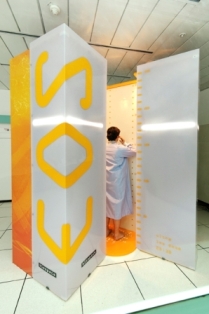The EOS orthopedic imaging machine captures head-to-toe images of patients in a standing position. This groundbreaking technology produces high quality images using significantly less radiation than a standard X-ray — up to 9 times less. The lower radiation is particularly important for children with spinal abnormalities, who will be monitored throughout their lifetimes.
The EOS provides remarkable detail and can produce three-dimensional images of the spine, enabling physicians to provide a more accurate diagnosis and plan an effective course of treatment.
Frequently Asked Questions
Is the EOS available to all patients at Rady Children’s?Any child needing a standing X-ray of the spine and has an order from his or her physician can have an X-ray on the EOS machine.
How can my child get an X-ray on the EOS machine?You need to have a referral and order from a physician. The order must provide a diagnosis and be written as follows: “AP/LAT STANDING T/L SPINE ON EOS”
If my child is scheduled for X-rays at Rady Children’s, can I request that they be taken on the EOS machine?No. You must have an order from a physician.
How old does a child have to be to get an X-ray on the EOS machine?
A child needs to be able to follow directions and stand completely still, by himself, in the EOS machine for up to 20 seconds.

Can my child have an EOS X-ray for his broken bone?
No. The EOS is used only for standing X-rays of the spine, not for X-rays of the arm, leg, hand or foot.
Is there an additional charge for an EOS X-ray?
No. The charge is the same as a traditional X-ray.
Will my insurance cover the cost of an EOS X-ray?
If your insurance plan covers outpatient X-rays, it should cover an X-ray on the EOS machine. To make sure the EOS is covered, contact your insurance plan.
What if my child can’t have an EOS X-ray? Are regular X-rays still safe?
Yes. All X-rays performed at Rady Children’s use the lowest radiation dose possible to produce the highest quality images. We follow the
ALARA imaging standard: As Low As Reasonably Achievable.
Will you be using a lead shield for this exam?
No. The lead shield or apron blocks the anatomy the physician needs to see.
How many X-rays will you be taking?
Just one X-ray is needed.